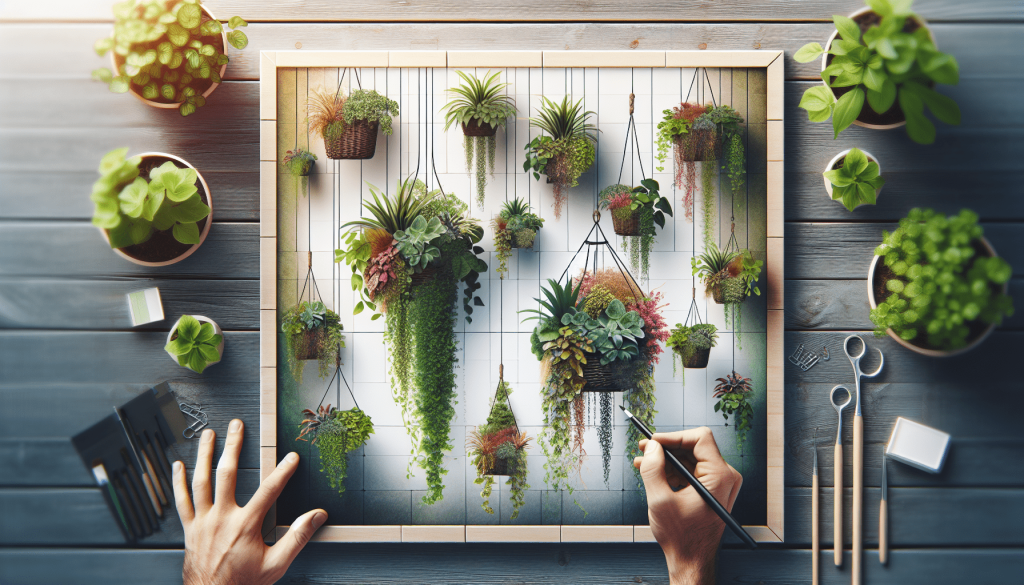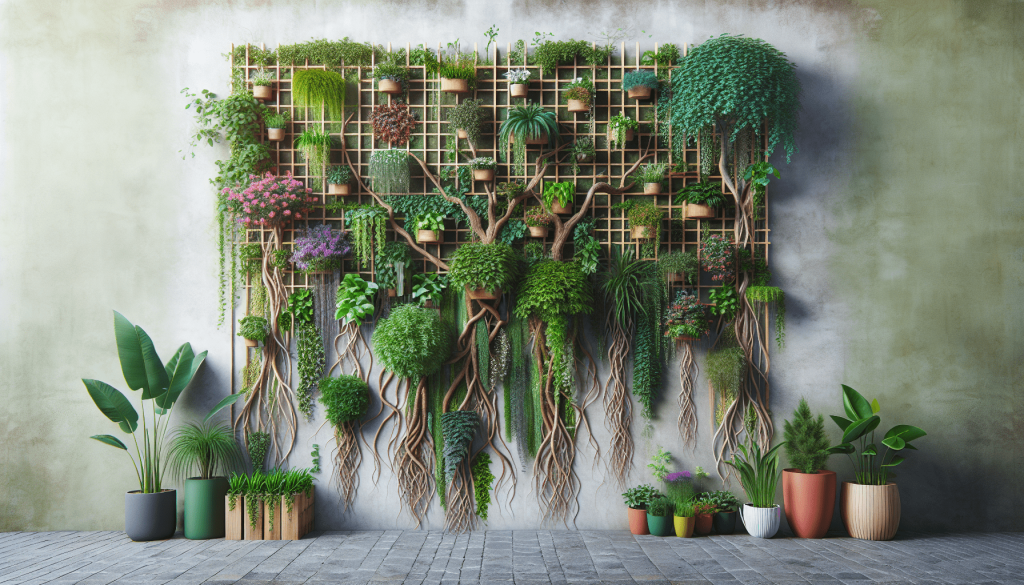This post may contain affiliate links. As an Amazon Associate, we may earn commissions from qualifying purchases.
Looking to maximize your gardening space? Look no further! In this article, we’ll explore the innovative concept of growing plants vertically to save space. Discover the practical and space-saving techniques that will revolutionize your gardening experience. Whether you have a small balcony or a limited backyard, we’ve got you covered with tips and tricks to help you create a flourishing vertical garden. Say goodbye to crowded planting beds and hello to a more efficient and aesthetically pleasing garden setup. Let’s dive in and learn how to make the most out of your gardening space!
Choosing the Right Plants
When it comes to vertical gardening, choosing the right plants is crucial for success. There are a few key factors to consider when selecting plants for your vertical garden. First, you need to consider the size and weight of the plants. Some plants, such as large vines or climbing roses, may be too heavy for certain structures. It is important to choose plants that will not overwhelm the vertical supports you have in place.
In addition to considering plant size and weight, it is also important to select plants that can grow vertically. Look for plants with climbing or vining habits, as these are ideal for vertical gardening. Some popular options include tomatoes, peas, cucumbers, and various types of climbing flowers.
Structures for Vertical Planting
Once you have chosen the right plants for your vertical garden, it is time to consider the structures that will support their growth. There are several options to choose from, each with its own unique benefits.
Trellises
Trellises are a popular choice for vertical gardening, as they offer support for climbing plants while adding an attractive aesthetic element to your garden. They are typically made of wood or metal and can be freestanding or attached to a wall or fence.
Arbors and Pergolas
Arbors and pergolas provide a more substantial structure for vertical gardening. They not only offer support for climbing plants but also create a beautiful focal point in your garden. These structures can be made from wood, metal, or even vinyl, depending on your preference.
Vertical Planters
Vertical planters are specifically designed for vertical gardening. They are often made of fabric, plastic, or metal and feature pockets or compartments for planting your desired plants. These planters are a convenient option if you have limited space or want to create a vertical garden on a balcony or patio.
Fence and Wall Gardens
If you have an existing fence or wall, you can turn it into a vertical garden by using hanging baskets, wall-mounted planters, or even repurposing old pallets. This option allows you to maximize the use of your vertical space without adding additional structures.
Hanging Baskets
Hanging baskets are a versatile option for vertical gardening. You can hang them from a pergola, trellis, or any other sturdy structure. They are perfect for trailing plants such as ivy or petunias.

Preparing the Soil
Before planting your vertical garden, it is important to prepare the soil properly. This will ensure that your plants have the necessary nutrients and drainage for healthy growth.
Ensure Good Drainage
Proper drainage is essential for vertical gardens. Since water drains quickly through vertical structures, it is important to have soil that allows excess water to flow away from the roots. Adding coarse sand or perlite to the soil mix can improve drainage and prevent waterlogging.
Improve Soil Fertility
To promote healthy plant growth, it is crucial to have fertile soil. Adding compost or organic matter to the soil will provide essential nutrients and improve its overall fertility. Consider using a slow-release fertilizer specifically formulated for container or vertical gardening to supplement the soil’s nutrient content.
Planting Techniques
Once your soil is prepared, it’s time to start planting your vertical garden. There are a few key planting techniques to keep in mind for successful growth.
Start with Healthy Seedlings
Using healthy seedlings is essential for strong and vigorous plants. Whether you grow your own seedlings or purchase them from a nursery, make sure they are free from pests or diseases. Avoid using weak or root-bound seedlings, as they may struggle to establish themselves in a vertical garden.
Proper Spacing and Arrangement
When planting your vertical garden, pay attention to the spacing between plants. Overcrowding can lead to competition for resources and hinder proper growth. Follow the recommended spacing guidelines for each plant species to ensure optimal growth and airflow. Consider arranging plants with the tallest ones at the back and the shorter ones in front to create a visually appealing vertical garden.

Support and Training
As your plants begin to grow, they will require support and training to ensure they stay on track and grow in the desired direction.
Staking and Tying
For plants that require vertical support, such as tomatoes or beans, staking and tying them to their supports is crucial. This prevents them from drooping or sprawling in an uncontrolled manner. Use soft ties or garden twine to gently secure the plants to their support structure, taking care not to damage the stems or foliage.
Using Plant Clips and Hooks
For plants with delicate vines or tendrils, using plant clips or hooks can help guide their growth along the vertical structure. These clips and hooks can be easily attached to trellises or other support systems, providing a gentle grip for the plants to cling to as they grow.
Pruning and Pinching
Regular pruning and pinching are essential for maintaining the shape and overall health of your vertical garden. By removing excess growth or undesirable branches, you can promote better airflow, reduce the risk of pests and diseases, and encourage the plants to focus their energy on producing flowers or fruits.
Watering and Fertilizing
Proper watering and fertilizing are vital for the successful growth of your vertical garden. Here are some tips to keep in mind:
Using Drip Irrigation Systems
In a vertical garden, watering from the top can be challenging, as water tends to drain quickly. Using a drip irrigation system can help deliver water directly to the plant’s roots, ensuring they receive enough moisture without excessive pooling or runoff. This method also helps conserve water by minimizing evaporation.
Choosing Appropriate Fertilizers
Vertical gardens can have unique soil conditions, so it’s important to choose fertilizers that cater to their specific needs. Look for slow-release fertilizers formulated for container or vertical gardening. These fertilizers gradually release nutrients over time, providing a steady supply for your plants’ growth and development.
Managing Pests and Diseases
No garden is immune to pests and diseases, and vertical gardens are no exception. Implementing organic pest control methods and regularly monitoring your plants can help prevent and manage these issues.
Implementing Organic Pest Control Methods
To protect your vertical garden from pests, opt for organic pest control methods. These can include using insecticidal soaps, neem oil, or introducing beneficial insects such as ladybugs or lacewings. Avoid using chemical pesticides, as they can harm the environment and beneficial insects.
Regular Monitoring and Early Intervention
Regularly inspect your plants for any signs of pests or diseases. Early intervention can prevent the problem from spreading and causing significant damage. Remove any infected or infested leaves, and consider using organic treatments or natural remedies to control the issue. Keeping your vertical garden clean and practicing good garden hygiene can also help reduce the risk of pests and diseases.
Harvesting and Maintenance
As your plants reach maturity, it is important to know the proper harvesting techniques specific to each plant species. Additionally, regular maintenance is necessary to ensure the productivity and longevity of your vertical garden.
Proper Harvesting Techniques
When it’s time to harvest your vertical garden, make sure you know the optimal harvesting techniques for each crop. Some plants, like tomatoes, are best picked when fully ripe, while others, like leafy greens, can be continuously harvested by cutting off individual leaves. Proper harvesting techniques will prevent damage to the plant and ensure the best flavor and quality.
Regular Pruning and Maintenance
Maintaining your vertical garden involves regular pruning and tidying up. Remove any dead or yellowing leaves, trim excess growth, and train plants to stay within their designated space. Regular maintenance not only improves the appearance of your vertical garden but also promotes healthy growth and reduces the risk of pest and disease issues.
Decorative Elements for Vertical Gardens
Vertical gardens can also be visually appealing, and choosing the right decorative elements can enhance their overall aesthetic.
Choosing Decorative Elements like Containers and Trellises
When selecting containers for your vertical garden, consider using unique or decorative pots that complement the style of your garden. Additionally, choose trellises, arbors, or pergolas that have an attractive design to add visual interest to your vertical garden.
Selecting Plants for Aesthetics
In addition to decorative elements, selecting plants for their aesthetic appeal can transform your vertical garden into a stunning display. Choose plants with vibrant flowers, lush foliage, or interesting textures to create visual interest and variety.
Tips and Tricks
To take your vertical gardening to the next level, consider implementing these tips and tricks:
Utilizing Vertical Space Indoors
Vertical gardening is not limited to outdoor spaces. Utilize vertical space indoors by installing wall-mounted planters or incorporating hanging baskets to create a green oasis even in small apartments or offices. This not only saves space but also adds a touch of greenery to your indoor environment.
Creating a Green Wall
A green wall, also known as a living wall, is a beautiful way to maximize your vertical space. Utilize a sturdy vertical structure, such as a metal frame or wooden pallet, and fill it with a mixture of plants. This creates an impressive living artwork that provides both visual appeal and environmental benefits.
Mixing Plant Varieties
Don’t be afraid to mix different plant varieties in your vertical garden. Combining plants with various heights, colors, and textures adds depth and interest to your garden. Consider pairing vines with cascading plants or mixing different flower colors for an eye-catching display.
In conclusion, growing plants vertically is a fantastic way to maximize space, create a visually stunning garden, and enjoy the benefits of fresh produce or beautiful blooms. By considering plant size and weight, choosing appropriate structures, preparing the soil, implementing proper planting techniques, providing support and training, managing water and fertilizer needs, addressing pests and diseases, maintaining the garden, adding decorative elements, and utilizing helpful tips and tricks, you can successfully grow plants vertically. So start exploring the world of vertical gardening and transform your space into a thriving oasis of greenery and beauty.








